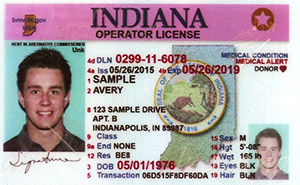Free Indiana BMV Permit Practice Test 2024 | IN

Verified by Steven Litvintchouk, M.S., Chief Educational Researcher, Member of ACES. See our detailed commitment to accuracy and quality in our practice tests.
4.34 out of 5 • 6072 votes
6 min to complete
Available in EN, ES, RU
This Indiana BMV practice test has just been updated for September 2024 and covers 40 of the most essential road signs and rules questions directly from the official 2024 IN Driver Handbook. For those 16 or older, getting an Indiana learner’s permit is easy – just pass a knowledge test and a standard vision test. If you’re between 15 and 16, you’ll need to pass both tests as well as show proof that you have enrolled in a driving education program. There will be 50 questions on the BMV written test divided into two categories; you’ll need to correctly answer at least 28 of the 34 on road rules and 14 of the 16 questions on road signs to pass and receive your permit. You must wait until the next business day if you need to retake your knowledge test. With a little study and help from this free BMV practice test, you should be able to pass with no trouble at all since the questions on the real test are drawn from the 2024 Driver’s Manual.
What to expect on the actual exam
correct answers to pass
minimum age to apply
Helpful links
FAQs
How many questions are on the Indiana permit test?
The Indiana permit test consists of 50 questions.
How many attempts are allowed for the permit test in Indiana?
You can take the permit test in Indiana a maximum of three times within a year from the date of your first attempt.
What is the maximum number of questions you can miss on the Indiana permit test?
You can miss up to 14 questions on the Indiana permit test; you must correctly answer 36 out of 50 questions to pass.
What are the requirements for taking the permit test in Indiana?
To take your permit test in Indiana, you need to provide proof of identity, residency, legal presence, and Social Security number, along with passing a vision screening.
Effective strategies for studying for the Indiana permit test
Study the Indiana Driver’s Manual thoroughly and take several practice tests to familiarize yourself with the test format and types of questions.
More resources
Easy
- IN BMV Practice Test 1
- IN BMV Practice Test 2
- IN BMV Practice Test 3
- IN BMV Practice Test 4
- IN BMV Practice Test 5
Hard
- IN T/F Road Sign Test
- IN Signs & Situations Test
- IN Road Signs Mini
Hardest
- IN Fines & Limits Test
- IN Distracted Driving Test
- IN Drinking & Driving Test
Simulator
Are you in another state?
- Alabama: Test 1 / Test 2
- Alaska: Test 1 / Test 2
- Arizona: Test 1 / Test 2
- Arkansas: Test 1 / Test 2
- California: Test 1 / Test 2
- Colorado: Test 1 / Test 2
- Connecticut: Test 1 / Test 2
- Delaware: Test 1 / Test 2
- District of Columbia: Test 1 / Test 2
- Florida: Test 1 / Test 2
- Georgia: Test 1 / Test 2
- Hawaii: Test 1 / Test 2
- Idaho: Test 1 / Test 2
- Illinois: Test 1 / Test 2
- Indiana: Test 1 / Test 2
- Iowa: Test 1 / Test 2
- Kansas: Test 1 / Test 2
- Kentucky: Test 1 / Test 2
- Louisiana: Test 1 / Test 2
- Maine: Test 1 / Test 2
- Maryland: Test 1 / Test 2
- Massachusetts: Test 1 / Test 2
- Michigan: Test 1 / Test 2
- Minnesota: Test 1 / Test 2
- Mississippi: Test 1 / Test 2
- Missouri: Test 1 / Test 2
- Montana: Test 1 / Test 2
- Nebraska: Test 1 / Test 2
- Nevada: Test 1 / Test 2
- New Hampshire: Test 1 / Test 2
- New Jersey: Test 1 / Test 2
- New Mexico: Test 1 / Test 2
- New York: Test 1 / Test 2
- North Carolina: Test 1 / Test 2
- North Dakota: Test 1 / Test 2
- Ohio: Test 1 / Test 2
- Oklahoma: Test 1 / Test 2
- Oregon: Test 1 / Test 2
- Pennsylvania: Test 1 / Test 2
- Rhode Island: Test 1 / Test 2
- South Carolina: Test 1 / Test 2
- South Dakota: Test 1 / Test 2
- Tennessee: Test 1 / Test 2
- Texas: Test 1 / Test 2
- Utah: Test 1 / Test 2
- Vermont: Test 1 / Test 2
- Virginia: Test 1 / Test 2
- Washington: Test 1 / Test 2
- West Virginia: Test 1 / Test 2
- Wisconsin: Test 1 / Test 2
- Wyoming: Test 1 / Test 2
Your go-to, trusted source
Experience the Driving-Tests difference
Since our foundation in 2010, Driving-Tests.org has led the way in online driver's education, with over a decade of experience. Our dedicated experts, bringing together more than 50 years of collective expertise, have established us as the largest non-governmental organization in the U.S. solely focused on driver education. We go beyond the official manuals, offering unique interactive experiences and support like audio guides and an AI Assistant, to cater to different learning styles and needs.
Helping hundreds of thousands to ace their tests, our resources have earned a 4.7-star rating from over 14,500 reviews. Our goal is to make your path to becoming a confident driver as straightforward and effective as possible.
Close Created with Sketch.
Our commitment to accuracy and quality in our practice tests
Explore our rigorous, multi-tiered verification process that ensures each question mirrors the official manual for unparalleled accuracy.

Written by Andrei Zakhareuski Updated over a week ago
At Driving-Tests.org, we understand the importance of reliable and accurate practice tests to help you prepare for your DMV exam. That's why we've developed a meticulous process to create and continually update our practice questions, ensuring they reflect the most current driving laws and regulations.
Here's an inside look at how we maintain the highest quality in our practice tests.
Content Creation and Verification Process
- Alignment with Official Manuals:
Every question we develop is based on the most recent version of each state's official driving manual. Our team regularly monitors each state DMV's website for the latest updates to ensure our practice tests are always aligned with the most current information.
- Community Feedback Integration:
We leverage feedback from our vast community of users to understand which topics are most frequently tested. This helps us focus on the areas that are most relevant and beneficial for your preparation.
- Expert Content Creation:
Our in-house editor, Steven, who has extensive experience in driver education, crafts each question with precision. He conducts a thorough review of each question against the official manuals to ensure accuracy.
- Rigorous Review Process:
Once Steven has finalized a set of questions, our team conducts a joint review session. This second level of scrutiny involves content accuracy, proofreading, and fact-checking to eliminate any errors.
- User Feedback Mechanism:
After a question goes live on our site, we keep the lines of communication open. Each question features a feedback button, inviting users to report any issues or errors. This continuous feedback loop allows us to address and rectify any concerns promptly.
- Responsive Updates:
In line with our commitment to accuracy, we quickly update our practice questions to reflect any changes in the DMV manuals. Additionally, we update the free electronic copy of the state's driver's license manuals on our site, typically within a few days after the DMV publishes them.
Our thorough quality control process ensures that you have access to practice tests that are as accurate and up-to-date as possible. We believe in the power of well-prepared drivers and are dedicated to providing you with the best study tools to help you succeed on your DMV exam.
List of questions (classic view)
- If you get a blowout or flat tire, what should you do first?
- On a multilane roadway with a speed limit of 50 mph or greater, you must signal your intention to change lanes ________ in advance.
- When making a U-turn, you must NOT
- What does this signal mean?
- The maximum speed limit in a highway work zone is at least _________ below the maximum established speed limit for the area.
- To leave yourself adequate room to stop, you should stay at least _________ behind the vehicle ahead of you.
- If a tornado is nearby, you must
- What does this sign mean?
- What should you do if fog closes in completely while you are driving, and visibility is reduced to near zero?
- When visibility is diminished, you must use low beams when you are
- If your disc or drum brakes suddenly fail, you should
- This sign indicates
- To avoid the effects of glare of oncoming headlights, do not look directly into the lights of the approaching vehicle. Instead,
- If you are driving near a school, you must slow down to _________ for the school zone.
- To enter a roundabout, you must proceed
- This service sign indicates that
- The likelihood of an accident increases if a driver is under the influence of
- When you enter an interstate on-ramp, stay to the right and __________ to allow your car to merge with traffic.
- Indiana law requires the driver and all passengers to use seat belts whenever a vehicle is
- This figure indicates
- You must avoid _________ while crossing railroad tracks.
- When a vehicle turns, its rear wheels will follow a _________ than its front wheels.
- When you see a stationary emergency vehicle with flashing lights, you must
- This sign indicates
- It is dangerous and illegal to try to pass other vehicles when you are within _________ of an intersection, railroad crossing, bridge, viaduct, or tunnel.
- If you are approaching a stop sign, you must
- Which of the following statements about driving on highways is true?
- What does this sign mean?
- A flashing red light at an intersection is equivalent to
- If another vehicle is passing you on the left, allow the other vehicle to pass safely, and
- In most urban residential areas, you may not exceed
- This sign indicates
- What is the first rule of a safe and legal turn?
- If you are involved in an accident, you must
- A yield sign indicates that you must slow down when approaching an intersection and be prepared to __________ if a vehicle or pedestrian with the right-of-way is approaching from another direction.
- What does this sign indicate?
- When operating a vehicle with a steering wheel interlock system, never turn _________ while the vehicle is in motion.
- If you are approaching an intersection with a non-operating signal, you should
- Flashing arrow boards (panels) are often used to indicate
- What does this figure mean?



